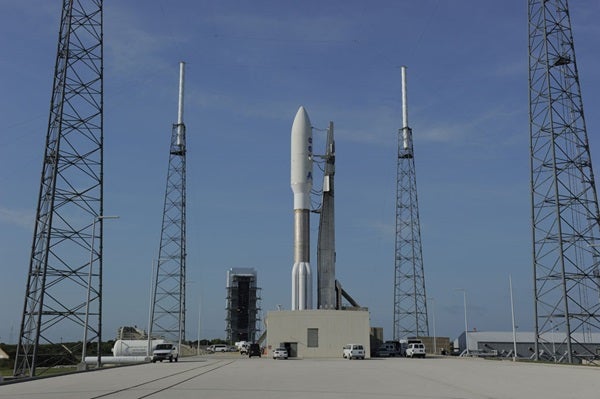“Our next move will be much farther — about 1,740 million miles (2,800 million kilometers) to Jupiter,” said Jan Chodas from NASA’s Jet Propulsion Laboratory in Pasadena, California. “The rollout completes Juno’s journey on Earth, and now we’re excited to be taking our first step into space.”
The launch period for Juno opens August 5 and extends through August 26. The spacecraft is expected to arrive at Jupiter in 2016. For an August 5 liftoff, the launch window opens at 11:34 a.m. EDT and remains open through 12:43 p.m. EDT.
At Cape Canaveral, Atlas V rockets are assembled vertically on a mobile launch platform in the Vertical Integration Facility south of the pad. The mobile platform, carrying Juno and its rocket, was rolled out to the pad using four 250-ton (227,000 kilograms) railcars.
When launched, Juno will take almost 11 minutes to reach its temporary orbit around Earth. About 30 minutes later, the Atlas rocket’s second stage will perform a second, 9-minute burn, after which Juno will be on its 5-year journey to the largest planet in the solar system.
The solar-powered Juno spacecraft will orbit Jupiter’s poles 33 times, investigating the gas giant’s origins, structure, atmosphere, and magnetosphere. Juno’s color camera will provide close-up images of Jupiter, including the first detailed glimpse of the planet’s poles.
“Our next move will be much farther — about 1,740 million miles (2,800 million kilometers) to Jupiter,” said Jan Chodas from NASA’s Jet Propulsion Laboratory in Pasadena, California. “The rollout completes Juno’s journey on Earth, and now we’re excited to be taking our first step into space.”
The launch period for Juno opens August 5 and extends through August 26. The spacecraft is expected to arrive at Jupiter in 2016. For an August 5 liftoff, the launch window opens at 11:34 a.m. EDT and remains open through 12:43 p.m. EDT.
At Cape Canaveral, Atlas V rockets are assembled vertically on a mobile launch platform in the Vertical Integration Facility south of the pad. The mobile platform, carrying Juno and its rocket, was rolled out to the pad using four 250-ton (227,000 kilograms) railcars.
When launched, Juno will take almost 11 minutes to reach its temporary orbit around Earth. About 30 minutes later, the Atlas rocket’s second stage will perform a second, 9-minute burn, after which Juno will be on its 5-year journey to the largest planet in the solar system.
The solar-powered Juno spacecraft will orbit Jupiter’s poles 33 times, investigating the gas giant’s origins, structure, atmosphere, and magnetosphere. Juno’s color camera will provide close-up images of Jupiter, including the first detailed glimpse of the planet’s poles.










